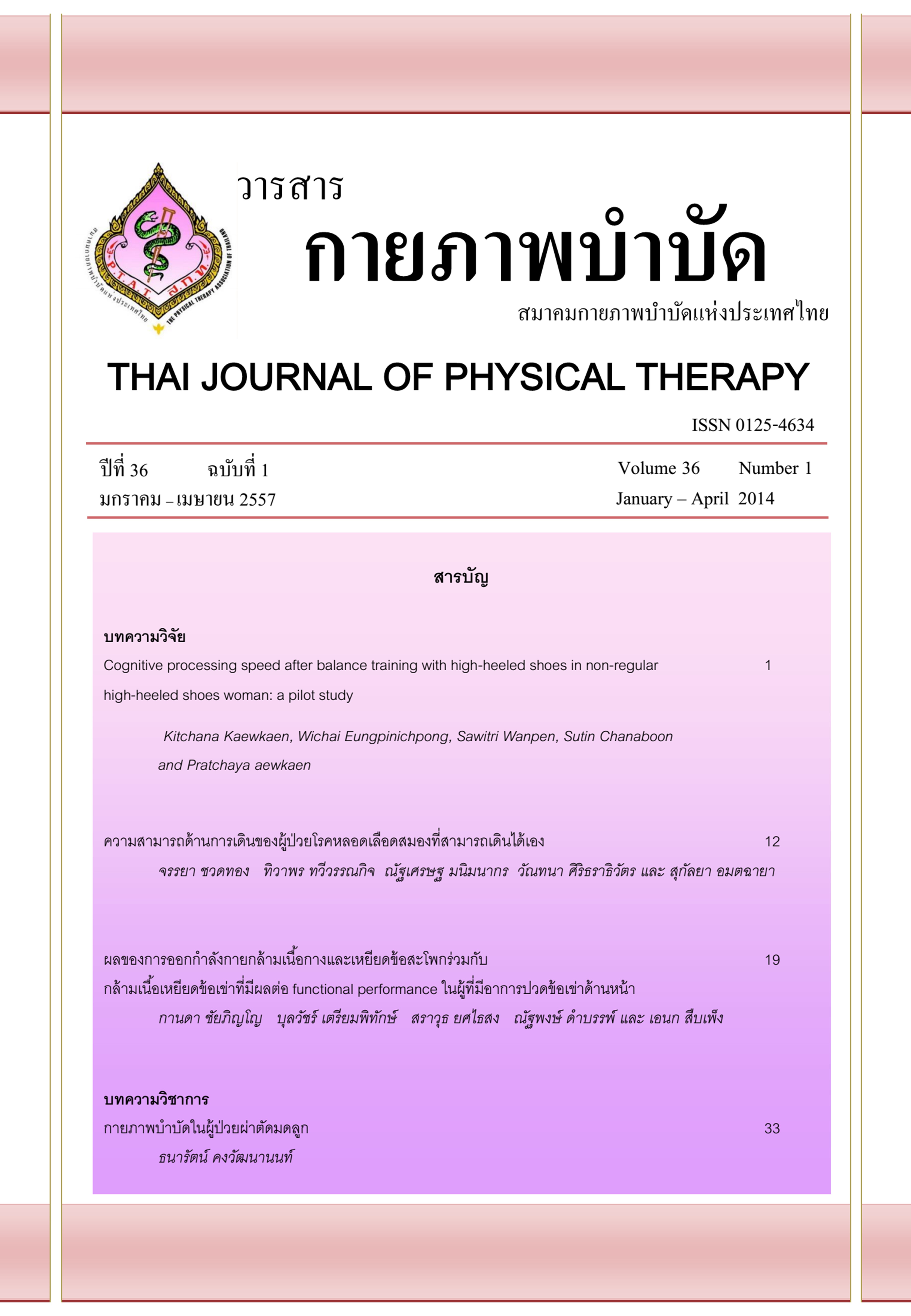ความเร็วของการประมวลผลการรู้คิดหลังการฝึกการทรงตัวด้วยรองเท้าส้นสูงในผู้หญิงที่ไม่ได้สวมรองเท้าส้นสูงเป็นประจำ: การศึกษานำร่อง
Main Article Content
บทคัดย่อ
การทำกิจกรรมพร้อมกันสองอย่างในชีวิตประจำวันนั้นทำให้ความสามารถในการควบคุมตัวและการรู้คิดลดลง หลายๆการศึกษาพบว่ามีการพัฒนาการควบคุมตัวในขณะที่ทำกิจกรรมพร้อมกันสองอย่างหลังจากที่มีการฝึก แต่ยังไม่มีการศึกษาเกี่ยวกับการรู้คิดหลังจากที่มีการฝึก การสวมรองเท้าส้นสูงร่วมกับมีการใช้ความคิดในขณะที่ทำงานทำให้มีการลดลงของความมั่นคงการทรงตัวและ/หรือการรู้คิด โดยเฉพาะในช่วงแรกของการสวมใส่ ผู้ที่ไม่ได้สวมรองเท้าส้นสูงเป็นประจำอาจทำให้ความมั่นคงการทรงตัวลดลงมากกว่าผู้ที่สวมรองเท้าส้นสูงเป็นประจำ วัตถุประสงค์ของการศึกษานี้คือ 1)เพื่อศึกษาผลทันทีของการฝึกการทรงตัวด้วยรองเท้าส้นสูงต่อความเร็วของการประมวลผลการรู้คิดในผู้ที่ไม่ได้สวมรองเท้าส้นสูงเป็นประจำ 2) เพื่อศึกษาเปรียบเทียบความเร็วของการประมวลผลการรู้คิดเมื่อได้รับการฝึกการทรงตัวบนรองเท้าส้นสูงระหว่างท่ายืนและท่านั่ง อาสาสมัครผู้หญิงสุขภาพดีจำนวน 10 คน ได้เข้าร่วมการศึกษาทดลองแบบไขว้กันโดยสุ่มลำดับของวิธีการฝึก ซึ่งอาสาสมัครจะได้รับการฝึก 2 วิธีคือการฝึกการทรงตัวด้วยการสวมรองเท้าส้นสูงในขณะที่ยืนและการฝึกการทรงตัวด้วยการสวมรองเท้าส้นสูงในขณะที่นั่ง แต่ละวิธีการฝึกจะใช้เวลา 45 นาทีและมีระยะพัก 7 วัน การวัดผลได้ทำการวัดความเร็วของการประมวลผลการรู้คิดก่อนและทันทีของการทดลอง ผลการศึกษาพบว่าหลังการฝึกนั้นความเร็วของการประมวลผลการรู้คิดมีการเพิ่มขึ้นทั้ง 2 วิธีการฝึก แต่ไม่พบความแตกต่างกันอย่างมีนัยสำคัญทางสถิติของความเร็วของการประมวลผลการรู้คิดและระยะทางการเคลื่อนที่ของจุดศูนย์กลางแรงกดจากเท้าระหว่างวิธีการฝึกทั้ง 2 วิธี ซึ่งต้องการการศึกษาต่อไปในขนาดตัวอย่างมากขึ้น
Article Details
เอกสารอ้างอิง
2. Horak FB. Postural orientation and equilibrium: what do we need to know about neural control of balance to prevent falls? Age Ageing 2006; 35 Suppl 2: ii7-ii11.
3. Jacobs JV, Horak FB. Cortical control of postural responses. J Neural Transm 2007; 114: 1339-48.
4. Maki BE, McIlroy WE. Cognitive demands and cortical control of human balance-recovery reactions. J Neural Transm 2007; 114: 1279-96.
5. Ren J, Wu YD, Chan JSY, Yan JH. Cognitive aging affects motor performance and learning. Geriatr Gerontol Int 2013; 13: 19-27.
6. Schmidt RA, Lee TD. Motor control and learning: A Behavioral Emphasis. 5th ed. Human kinetics publishers, 2011.
7. Tombu M, Jolicoeur P. A central capacity sharing model of dual-task performance. J Exp Psychol Hum Percept Perform 2003; 29: 3-18.
8. Shumway-Cook A, Woollacott M. Motor control: translating research in to clinical practice. 4th ed. Lippincott Williams & Wilkins, 2012.
9. Prado JM, Stoffregen TA, Duarte M. Postural sway during dual tasks in young and elderly adults. Gerontology 2007;53: 274-81.
10. Al-Yahya E, Dawes H, Smith L, Dennis A, Howells K, Cockburn J. Cognitive motor interference while walking: a systematic review and meta-analysis. Neurosci Biobehav Rev 2011; 35: 715-28.
11. Andersson G, Hagman J, Talianzadeh R, Svedberg A, Larsen HC. Effect of cognitive load on postural control. Brain Res Bull 2002; 58: 135-9.
12. Srygley JM, Mirelman A, Herman T, Giladi N, Hausdorff JM. When does walking alter thinking? Age and task associated findings. Brain Res 2009; 1253: 92-9.
13. Silsupadol P, Lugade V, Shumway-cook A, Donkelaar PV, Chou LS, Mayr U, Woollacott M. Training-related changes in dual-task walking performance of elderly persons with balance impairment: a double-blind, randomized controlled trial. Gait Posture 2009; 29: 634-9.
14. Fritz NE, Basso DM. Dual-task training for balance and mobility in a person with severe traumatic brain injury: a case study. J Neurol Phys Ther 2013; 37: 37-43.
15. Taubert M, Villringer A, Ragert P. Learning-related gray and white matter changes in humans: an update. Neuroscientist 2012; 18: 320-5.
16. Kitago T, Krakauer JW. Motor learning principles for neurorehabilitation. Handb Clin Neurol 2013; 110: 93-103.
17. Gefen A, Megido-Ravid M, Itzchak Y, Arcan M. Analysis of muscular fatigue and foot stability during high-heeled gait. Gait Posture 2002; 15: 56-63.
18. Kim Y, Lim JM, Yoon B. Changes in ankle range of motion and muscle strength in habitual wearers of high-heeled shoes. Foot Ankle Int 2013; 34: 414-9.
19. Lee CM, Jeong EH, Freivalds A. Biomechanical effects of wearing high-heeled shoes. International Journal of Industrial Ergonomics. 2001; 28: 321-6.
20. Gerber SB, Costa RV, Grecco LAC, Pasini H, Marconi NF, Oliveira CS. Interference of high-heeled shoes in static balance among young women. Hum Mov Sci 2012; 31: 1247-52.
21. Schaefer S, Lindenberger U. Thinking while walking: experienced high-heel walkers flexibly adjust their gait. Front Psychol. 2013; 4: 316-22.
22. Kaewkaen K, Eungpinichpong W, Wanpen S. The immediate effect of balance training on high heel shoes on cognitive performance of the non regular high-heel shoe wearers while balancing in high-heel shoes: a pilot study. Proceedings of international graduate research conference 2013; 2013 Dec 20; Chiang Mai University, Chiang Mai. 2013.
23. Silsupadol P, Siu K-C, Shumway-Cook A, Woolacott M. Training of balance under single- and dual-task conditions in older adults with balance impairment. Phys Ther. 2006; 86: 269-81.
24. Bauer JM, Bohlin E. From static to dynamic regulation recent developments in U.S. telecommunications policy. Intereconomics: Review of European Economic Policy. 2008; 43: 38-50.
25. Jonsson E, Seiger A, Hirschfeld H. Postural steadiness and weight distribution during tandem stance in healthy young and elderly adults. ClinBiomech (Bristol, Avon). 2005; 20: 202-8.
26. Clark RA, Bryant AL, Pua Y, McCrory P, Bennell K, Hunt M. Validity and reliability of the Nintendo Wii Balance Board for assessment of standing balance. Gait Posture. 2010; 31: 307-10.
27. Roerdink M, Hlavackova P, Vuillerme N. Center-of-pressure regularity as a marker for attentional investment in postural control: a comparison between sitting and standing postures. Hum Mov Sci 2011; 30: 203-12.
28. Donker SF, Roerdink M, Greven AJ, Beek PJ. Regularity of center-of-pressure trajectories depends on the amount of attention invested in postural control. Exp Brain Res 2007; 181: 1-11.
29. van Veen V, Krug MK, Carter CS. The neural and computational basis of controlled speed-accuracy tradeoff during task performance. J Cogn Neurosci 2008; 20: 1952-65.
30. Woollacott M, Shumway-Cook A. Attention and the control of posture and gait: a review of an emerging area of research. Gait Posture 2002; 16: 1-14.


